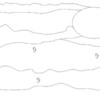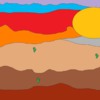Jesus in the Wilderness
Art Workshop
Summary of Lesson Activities:
Using Sand Art.
Scripture References:
Luke 4:1-13 and Matthew 4:1-11.
Lesson Objective:
- to empathize with the feelings that Jesus felt in the desert.
Materials List:
- Fine sand dyed in a variety of colors: it can be pre-bought this way or dyed with liquid or powdered fabric dye [Global Art by by MaryAnn Kohl and Jean Potter (Gryphon House. Beltsville, Maryland) has directions]
- Paint brushes
- Glue
- Plastic containers with lids (such as Gladware) to fill with colored sand or glue.
- Trays or large pieces of stiff paper
- Copies of a simple desert scene on cardstock
- Pan filled with warm sand (warm the sand in a warm oven before class)
- Salty pretzels
Leader Preparation:
- Read the story, Jesus Enters the Wilderness, in Luke 4:1-13 and Matthew 4:1-11. Notice that the accounts are similar except for the order that the temptations come in and the fact that Matthew mentions angels ministering to Jesus at the end of the account.
- Read the children’s version of the story at home and be prepared to paraphrase the story for grades K-2.
- Gather the materials.
- Experiment with the materials at home before class.
Note: We set up six stations in our art room. Each station had a container of glue, a container of colored sand, two brushes, and an art tray.Students rotated between stations to add colors to their "paintings"
Presentation
Opening-Welcome and Lesson Introduction:
Before the class begins, the group will meet for five minutes with their shepherd to do some “get to know you” questions such as “What was your high and your low this week?” or “Name some things that you can do with sand. Today we are going to ‘paint’ with sand.” This is also a good time to have each student repeat the bible verse of the month to the shepherd before class begins.
- Wear a nametag and introduce yourself. Explain that we will be talking about Jesus entering a desert. Today, we will try to get the feeling of being in a desert by touching sand and eating salty pretzels. Then we will paint a picture of the desert with sand.
- Ask the children whether or not they have ever been to a desert. What types of words describe deserts? Make a list on a white board.
- Have the children eat pretzels. Explain that the saltiness of the pretzels makes us thirsty like Jesus might have been in the desert.
Dig-Main Content and Reflection:
- Next have the children take turns feeling the sand in the pan. Explain that the sand in the desert in Judea where Jesus lived would have been hot and dry.
- Next, either you, the shepherd, or older children can read the bible story on pp. 270 and 271 of the "gold" Children’s Illustrated Bible by Victoria Parker. You should be prepared to paraphrase this story with children in grades K-2. Ask the children to try and count the number of times that Jesus was tempted in the story.
- Seat the children at the art tables. Distribute copies of a simple black-line desert scene that is divided into sections for different colors of sand (I made my own by tracing a picture I found on the internet).Older children may be able to generate their own simple outline drawings.
- Explain that each section on the picture will be a different color. Show the children a finished sample.
- Explain that we can “paint” with sand by painting a section with glue first and then covering it with sand. Demonstrate how to brush the section with glue and how to sprinkle the sand over the glue with a spoon.
- Only one section at time can be painted with glue and sprinkled with sand. The excess sand from one color can be shaken off on to a tray or large piece of stiff paper and returned to the container at the end of class by an adult.
- It is important to completely cover the glue so that sand from the other sections doesn’t stick there. Explain that it is best to start with dark colors because some sand always sticks to the wrong sections. It is better that the “stray” sand be light instead of dark.
- Have the children complete their artwork section by section while you and the shepherd circulate.
Wrap-Up: Lay the “paintings” out to dry and seat the children on the carpet.
Ask the children how they think Jesus felt being in the desert. (Even though Jesus was fully God and not capable of doing wrong, he could still feel pain and suffer because he was fully human.)
Read Luke 4:1
Ask, “Why do you think that the Holy Spirit would led Jesus into the desert to be tested?
Journal time:
Have the children think of some sentences to describe how Jesus must have felt in the desert for forty days without food. The sentences can be composed as a group on a white board and copied into individual journals.
Closing:
End with a prayer.
Have the children assist with the cleanup.
References:
- "Global Art" by MaryAnn Kohl and Jean Potter (Gryphon House. Beltsville, Maryland)
- "The Children's Illustrated Bible" by Victoria Parker.
A lesson posted by Dee Cobia, Director of Children's Ministries, BayMarin Community Church
San Rafael, CA
A representative of Rotation.org reformatted this post to improve readability.
In 2015, Luanne Payne created a drawing for this lesson. See attached photo and Desert Scene PDF to assist in the use of this lesson.




